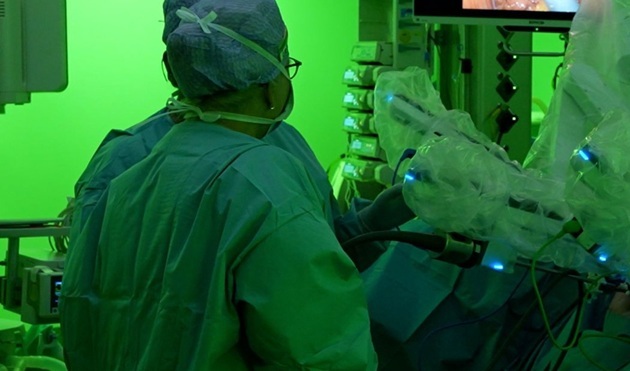Cross-Checking between ED Physicians Reduces Harm
|
By HospiMedica International staff writers Posted on 08 May 2018 |

Image: A new study suggests a few minutes of consultation can avoid adverse ED events (Photo courtesy of Dreamstime).
A new study suggests that systematic cross-checking between doctors may be a key to reducing the high rate of adverse events in the emergency department (ED).
Researchers at the Sorbonne University (Paris, France), Pitie-Salpetriere Hospital (Paris, France), and other institutions conducted a cluster randomized crossover trial that included a random sample of 1,680 patients attended to in six EDs in France during two 10-day periods. The intervention included systematic cross-checking between ED physicians three times a day, which included a brief presentation of one physician’s case to another, followed by the second physician’s feedback. The main outcome was medical error, defined as either a near miss or a serious adverse event.
The results showed that there were 54 adverse events among 840 patients (6.4%) during the cross-check intervention, compared with 90 adverse events among 840 patients (10.7%) during the control period, a relative reduction of 40%. Most of the reductions occurred in adverse events defined as near misses, with a reduction of 47%. Errors in sepsis management accounted for more than 40% of the preventable serious adverse events. The median duration of cross-checking sessions was nine minutes, during which about seven patients were discussed. The study was published on April 23, 2018, in JAMA Internal Medicine.
“The reduction in preventable serious adverse events with systematic cross-checking did not reach statistical significance; only reductions in near misses did,” explained lead author Yonathan Freund, MD, PhD, of Hôpital Pitié-Salpêtrière. “Whether an adverse event resulted from a misdiagnosis or from the implementation of an inappropriate plan for the correct diagnosis could not be determined decisively. This included sepsis-associated medical errors, which may be particularly relevant, because the most commonly occurring serious adverse events were violations of the surviving sepsis campaign guidelines.”
An adverse event is defined as a preventable or non-preventable injury that was caused by medical management (rather than the underlying disease) and that prolonged hospitalization, produced a disability at the time of discharge, or both. Adverse event also include errors, defined as acts of commission or omission leading to an undesirable outcome or significant potential for such an outcome, and near misses, in which an error was committed, but the patient did not experience clinical harm, either through early detection or sheer luck.
Related Links:
Sorbonne University
Pitie-Salpetriere Hospital
Researchers at the Sorbonne University (Paris, France), Pitie-Salpetriere Hospital (Paris, France), and other institutions conducted a cluster randomized crossover trial that included a random sample of 1,680 patients attended to in six EDs in France during two 10-day periods. The intervention included systematic cross-checking between ED physicians three times a day, which included a brief presentation of one physician’s case to another, followed by the second physician’s feedback. The main outcome was medical error, defined as either a near miss or a serious adverse event.
The results showed that there were 54 adverse events among 840 patients (6.4%) during the cross-check intervention, compared with 90 adverse events among 840 patients (10.7%) during the control period, a relative reduction of 40%. Most of the reductions occurred in adverse events defined as near misses, with a reduction of 47%. Errors in sepsis management accounted for more than 40% of the preventable serious adverse events. The median duration of cross-checking sessions was nine minutes, during which about seven patients were discussed. The study was published on April 23, 2018, in JAMA Internal Medicine.
“The reduction in preventable serious adverse events with systematic cross-checking did not reach statistical significance; only reductions in near misses did,” explained lead author Yonathan Freund, MD, PhD, of Hôpital Pitié-Salpêtrière. “Whether an adverse event resulted from a misdiagnosis or from the implementation of an inappropriate plan for the correct diagnosis could not be determined decisively. This included sepsis-associated medical errors, which may be particularly relevant, because the most commonly occurring serious adverse events were violations of the surviving sepsis campaign guidelines.”
An adverse event is defined as a preventable or non-preventable injury that was caused by medical management (rather than the underlying disease) and that prolonged hospitalization, produced a disability at the time of discharge, or both. Adverse event also include errors, defined as acts of commission or omission leading to an undesirable outcome or significant potential for such an outcome, and near misses, in which an error was committed, but the patient did not experience clinical harm, either through early detection or sheer luck.
Related Links:
Sorbonne University
Pitie-Salpetriere Hospital
Latest Critical Care News
- Ventricular Assist Device Offers Long-Term Use in Children Waiting for Donor Heart
- Precision Approach Improves Immunotherapy Effectiveness for ICU Patients with Sepsis
- Soft Robots Could Donate Their Heart to Humans
- Bioadhesive Strategy Prevents Fibrosis Around Device Implants on Peripheral Nerves
- Miniature Non-Invasive Robotic Catheters to Improve Infertility Treatments
- Stick-On Patch Monitors Baby's Movements In Utero
- EEG-Based AI Technology Accurately Diagnoses Alzheimer’s and Dementia
- Robot Lymphatic System Paves Way for Self-Powered Wearables and Machines
- Focused Ultrasound Technique Successfully Treats Pediatric Brain Cancer
- Nasal Drops Fight Brain Tumors Noninvasively
- AI Helps Optimize Therapy Selection and Dosing for Septic Shock
- Glowing Bacteria ‘Pills’ for Detecting Gut Diseases Could Eliminate Colonoscopies
- Skin-Permeable Polymer Patch Delivers Insulin Non-Invasively Through Skin
- Nanogel Technology Almost 100% Effective in Destroying Drug-Resistant Bacteria Within Hours
- Wearable Ultrasound Sensor Delivers Noninvasive Treatment Without Surgery
- Gel-Free ECG System to Transform Heart Health Diagnosis
Channels
Surgical Techniques
view channel
Minimally Invasive Surgery Proven Safe and Effective for Complex ‘Whipple’ Procedure
Tumors of the pancreatic head often require a highly complex operation known as pancreatoduodenectomy or the Whipple procedure. This surgery involves removing multiple structures and creating several internal... Read more
Catheter-Based Procedures Offer Less Invasive Option for Treatment of Valvular Disease
Valvular heart disease, caused by tight or leaky valves between heart chambers, affects up to 10% of older adults and leads to more than 120,000 deaths globally each year. Traditional open-heart surgery... Read morePatient Care
view channel
Revolutionary Automatic IV-Line Flushing Device to Enhance Infusion Care
More than 80% of in-hospital patients receive intravenous (IV) therapy. Every dose of IV medicine delivered in a small volume (<250 mL) infusion bag should be followed by subsequent flushing to ensure... Read more
VR Training Tool Combats Contamination of Portable Medical Equipment
Healthcare-associated infections (HAIs) impact one in every 31 patients, cause nearly 100,000 deaths each year, and cost USD 28.4 billion in direct medical expenses. Notably, up to 75% of these infections... Read more
Portable Biosensor Platform to Reduce Hospital-Acquired Infections
Approximately 4 million patients in the European Union acquire healthcare-associated infections (HAIs) or nosocomial infections each year, with around 37,000 deaths directly resulting from these infections,... Read moreFirst-Of-Its-Kind Portable Germicidal Light Technology Disinfects High-Touch Clinical Surfaces in Seconds
Reducing healthcare-acquired infections (HAIs) remains a pressing issue within global healthcare systems. In the United States alone, 1.7 million patients contract HAIs annually, leading to approximately... Read moreHealth IT
view channel
EMR-Based Tool Predicts Graft Failure After Kidney Transplant
Kidney transplantation offers patients with end-stage kidney disease longer survival and better quality of life than dialysis, yet graft failure remains a major challenge. Although a successful transplant... Read more
Printable Molecule-Selective Nanoparticles Enable Mass Production of Wearable Biosensors
The future of medicine is likely to focus on the personalization of healthcare—understanding exactly what an individual requires and delivering the appropriate combination of nutrients, metabolites, and... Read moreBusiness
view channel
Philips and Masimo Partner to Advance Patient Monitoring Measurement Technologies
Royal Philips (Amsterdam, Netherlands) and Masimo (Irvine, California, USA) have renewed their multi-year strategic collaboration, combining Philips’ expertise in patient monitoring with Masimo’s noninvasive... Read more
B. Braun Acquires Digital Microsurgery Company True Digital Surgery
The high-end microsurgery market in neurosurgery, spine, and ENT is undergoing a significant transformation. Traditional analog microscopes are giving way to digital exoscopes, which provide improved visualization,... Read more
CMEF 2025 to Promote Holistic and High-Quality Development of Medical and Health Industry
The 92nd China International Medical Equipment Fair (CMEF 2025) Autumn Exhibition is scheduled to be held from September 26 to 29 at the China Import and Export Fair Complex (Canton Fair Complex) in Guangzhou.... Read more













